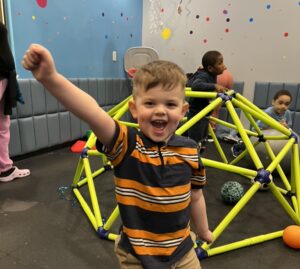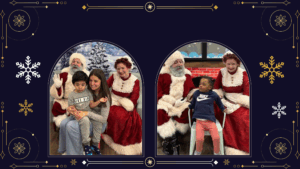With BY YOUR SIDE’s multidisciplinary approach, clients can typically receive therapy from multiple clinicians throughout the course of a day or week. These clinicians may include BCBAs, Registered Behavior Technicians, Behavior Technicians, Occupational Therapists, and Speech-Language Pathologists. Our clinicians collaborate and communicate with regards to the treatment plan for each client, so they can progress effectively.
Speech-Language Pathologists are experts in communication. They specialize in helping their clients with speech sounds, language, fluency, pragmatics, and more. At BY YOUR SIDE, we currently employ many Speech-Language Pathologists, including Melissa, who has been working at BY YOUR SIDE for nearly a year after graduating from Midwestern University. We shadowed Melissa to see what a day in the life of a Speech-Language Pathologist would look like. Check out what we learned!
Describe your position here at BY YOUR SIDE.
Melissa – I see kiddos for their speech goals, so it depends on what they are working on. We work on speech sounds, social skills, feeding therapy, and learning perceptive language.
What’s something that you enjoy about your position?
Melissa – I love seeing the kids be successful with something like they hit one of their goals or they just have a lightbulb moment. For a lot of kiddos, you can see it in their faces because they light up!
What does a typical day look like for you?
Melissa – When I arrive in the morning, I typically have time to plan lessons during my first hour and look at my caseload for the day. Who am I seeing? What activities do I want to run? What goals am I going to target? And get a plan of action for the day. Then I typically see kids back-to-back every hour for the rest of the day. So, we are running around but it makes time go pretty fast!
Give us an example of what a session with a client may look like.
Melissa – A typical session starts either in the gym or on the playground because it gets the kiddos moving which helps gain their attention. Then we will transition to the speech room or wherever they want to work, and we’ll run some goals and take breaks in between to play. All of our kiddos have different goals that they are targeting, so we could be working on pronouns or labeling pictures of pronouns, or we’re working on our different speech sounds.
Are there any specific tools you like to use during sessions?
Melissa – Some of our clients use the AAC devices (Augmentative and Alternative Communication) and it is probably one of my favorite areas in our field. I love the concept of helping kids find their voice in a different way than they might be able to do vocally at that time. I really like to emphasize modeling on these devices. They must be taught: What does this word even mean? For a lot of our kiddos, it is teaching: What is it? How do I use it? Then showing them how they can use that language throughout their activities. Helping them hear the different words they could be using and applying those in different ways is important. Whether it’s play, structured work, eating, or going to the bathroom, there are so many ways for us to be modeling the language for our kiddos in the center and for parents at home too.
Are there any other tools, besides AAC devices, that you like to use as well?
Melissa – It depends on what we are working on. If I am working on articulation and producing that specific sound, I might use a mirror so the kiddo can get the feedback of seeing themselves or seeing me produce it in a mirror. Especially now with masks, it’s very tricky. I have a specialized mask that helps; it has a clear plastic piece to let them still see what my mouth is doing because that visual assistance is huge for their understanding.
I also use a lot of picture cards or certain toys. With the population we work with, play skills are also very tricky for some of our kiddos. Using the toys they’re interested in, you can model the appropriate way to play. They just need that help of figuring out what to do with it in the first place.
Do you work with any other clinicians while you’re working with clients?
Melissa – I have co-treatments with some of the Behavior Technicians who are providing ABA therapy. I work closely with them and it is super helpful to collaborate! They are more trained on the behavior side of things, which is great because then they know the kiddos very well.
We also work with the BCBAs on their plans to see how we can carry over the goals that they’re working on in conjunction with what we’re working on. So that all in all, the kids are working the best way they can for that functional language and skills.
We also collaborate with the Occupational Therapists; we chat about shared clients and ask each other: What are you seeing? What am I seeing? How do you want me to carry this over? Especially with the language aspect, it’s super helpful that everyone’s on the same page so we can start to see these kids succeed in different ways and then we learn together how to work best with them.
To learn more about speech-language therapy and other services at BY YOUR SIDE, visit byyoursideac.com/services/.



